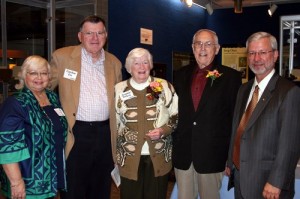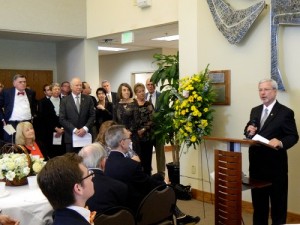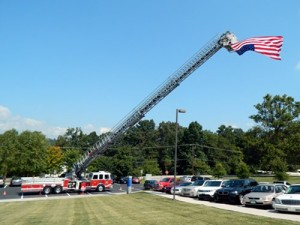
Now mostly demolished, the former mile-long, U-shaped K-25 Building is pictured above. Bill Wilcox, a former technical director at K-25 and the Y-12 National Security Complex, led the fight to preserve K-25’s history. Wilcox died Monday, Sept. 2, and his funeral was Saturday. (Photo courtesy of U.S. Department of Energy)
The fight to preserve the history of the K-25 site in west Oak Ridge was long and arduous. Among the challenges were federal funding battles and deteriorated building conditions.
Other people might have considered the dilapidated K-25 Building, once the world’s largest building under one roof, a “useless hulk,” one friend and colleague said. But historic preservationist Bill Wilcox, who died Monday evening, never gave up on his dream of honoring the site’s history.
Now mostly demolished, the mile-long, U-shaped K-25 Building was erected as part of the top-secret Manhattan Project. That was a federal program to build the world’s first atomic bombs during World War II. But the four-story building has been shut down since 1964 and fallen into disrepair, and the U.S. Department of Energy is converting the site into a massive industrial park and demolishing many of the original buildings.
Wilcox believed the giant K-25 Building, or at least part of it, could be used to help tell the story of how Oak Ridge helped end World War II—and create a “wow” experience for out-of-town visitors, said Cindy Kelly, president of the nonprofit Atomic Heritage Foundation in Washington, D.C.
Wilcox pursued that dream with passion and persistence. When one plan for preserving the 44-acre building, particularly its North End, was deemed unsuitable, Wilcox would draft another, officials said at a Saturday afternoon reception honoring the charismatic storyteller. The reception at Pollard Auditorium followed a funeral at St. Stephen’s Episcopal Church.
“He never did quit,” said Gerald Boyd, former manager of DOE’s Oak Ridge Office, who worked on K-25 proposals with Wilcox for about 10 years. “I was struck by his passion for this place.”
The K-25 site was built to enrich uranium for nuclear weapons during the war, and officials have said it later helped win the Cold War. Historic preservationists lobbied for years to save the building’s North End—the bottom of the U—but concerns over safety, the building’s deteriorated condition, and the cost of preserving even part of it made that impractical. An agreement officially announced Aug. 10, 2012, cleared the way for the North End to be demolished, but it also called for a replica equipment building and viewing tower, proposed a history center at a nearby city-owned fire station, and provided a $500,000 grant for the run-down Alexander Inn.

Bill Wilcox, second from right, with his wife Jeanie Wilcox, center; Gerald Boyd, right, former manager of the U.S. Department of Energy Oak Ridge Office; and longtime friend Gordon Fee and his wife Miriam Fee. (Photo by D. Ray Smith)
Officials gave much of the credit to Wilcox. They said he had worked tirelessly and formed the Partnership for K-25 Preservation, or PKP.
“He worked so hard to make sure we don’t forget the legacy of that site,” said longtime friend Gordon Fee, who was hired by Wilcox at K-25 in 1956 and went on to become president of Lockheed Martin Energy Systems.
“Bill’s heartfelt presentations, always delivered in a bow tie, were the highlight of many long and contentious meetings with DOE and other parties,” Kelly said.
The K-25 site itself was closed in 1987, and it could become part of a Manhattan Project National Historical Park under legislation pending in Congress. Wilcox worked with the National Park Service to include Oak Ridge in the park along with Los Alamos, N.M., and Hanford, Wash.
Wilcox also helped lead or played vital roles in other historical initiatives, including efforts to preserve the Alexander Inn, document the birth of Oak Ridge in plaques placed on monuments in front of the Municipal Building, serve as a guide on public bus tours of K-25, and build a Secret City Commemorative Walk at Alvin K. Bissell Park.
“For the last decade or more, no one did more to preserve Oak Ridge’s Manhattan Project history,” Kelly said.

Among those honoring Bill Wilcox during a Saturday reception are son William H. “Bill” Wilcox, center, front row; Gordon Fee, left, front row; author Denise Kiernan, to the right of Wilcox in the back row; Cindy Kelly, right, front row; and Gerald Boyd, right. “It’s just a fitting tribute to his remarkable life,” Wilcox said. “You can imagine how meaningful it is to us.”
Wilcox was cremated and his ashes buried in a handmade linen bag tied with a hand-knotted cord in a small, square 1’x1′ grave in the St. Stephen’s Memorial Garden. One by one, family and friends tearfully used a shovel to pile dirt on top of his remains. It’s an ancient custom among Episcopalians, but the burial option has become more popular within the last 20 years, said the Rev. Craig M. Kallio, who gave Saturday’s funeral homily in a service scripted by Wilcox several years ago.
“While we will miss Bill’s elegant and warm presence, we remain inspired by his beautiful soul,” Kallio said. “Some people come into our lives and quietly go. Others stay for a while and leave footprints on our hearts, and we are never the same.”
Wilcox was considered one of the two pillars of Oak Ridge who helped connect residents today with the city’s Manhattan Project era. Wilcox documented the city’s history in words, while Ed Westcott, the official government photographer in Oak Ridge during World War II, captured the city’s daily life—and powerful global role—in images. Westcott attended Saturday’s events.
“Without these two individuals, we wouldn’t be able to tell our story as effectively as we can,” said D. Ray Smith, Y-12 National Security Complex historian and newspaper columnist.
Wilcox was born Jan. 26, 1923, in Harrisburg, Pa., and he was 20 years old when he came to Oak Ridge seven decades ago as a chemist. He went on to become technical director for K-25 and Y-12, served as technical assistant to company presidents, and headed the independent Mercury Task Force investigating the use of mercury during the lithium separation years of 1955-1962 and its impacts on workers and the environment, among other things.
But he is most well-known today for his captivating storytelling and passion for preserving the city’s history.
“His passion for preserving the Manhattan Project history was matched by his unique ability to both present the ‘big picture’ and explain complex technical details,” Kelly said. “No wonder he was the first person television reporters and documentary filmmakers sought to interview about the Manhattan Project. He was the simply the best. We have lost an icon of the Manhattan Project and a truly great friend.”
For more information, see Wilcox’s obituary here. Download the Rev. Kallio’s homily here.
Note: This story was updated with more links and photos at 8:50 p.m.

Leave a Reply